YOUR HEARING
How we Hear
Of course, hearing is also one of our senses!” A most familiar remark when trying to list the five senses, but getting stuck after only four: sight, smell, taste, touch, and …? Hearing ─ a sense often taken for granted. Not here. At ACTIV-EARS Audiology, we are passionate about your hearing.
Hearing is one of the five senses. It is a complex process of picking up sound and attaching meaning to it.The ability to hear is critical to understanding the world around us. The human ear is a fully developed part of our bodies at birth and responds to sounds that are very faint as well as sounds that are very loud. Even before birth, infants respond to sound.
So, how do we hear? The ear can be divided into three parts leading up to the brain – the outer ear, middle ear and the inner ear. The inner ear is also called the cochlea. (‘Cochlea’ means ‘snail’ in Latin; the cochlea gets its name from its distinctive coiled up shape.)
The Magic of Hearing
Sound waves enter the ear canal and make the ear drum vibrate. This action moves the tiny chain of bones (ossicles – malleus, incus, stapes) in the middle ear. The last bone in this chain ‘knocks’ on the membrane window of the cochlea and makes the fluid in the cochlea move. The fluid movement then triggers a response in the hearing nerve.
The outer ear consists of the pinna, ear canal and eardrum. The middle ear consists of the ossicles (malleus, incus, stapes) and ear drum. The inner ear consists of the cochlea, the auditory (hearing) nerve and the brain
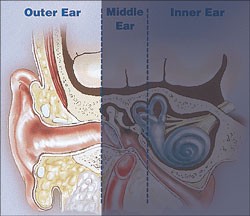
Outer Ear
The outer ear collects sound waves and funnels these through the ear canal towards the eardrum.
Middle Ear
Struck by sound waves, the eardrum begins to vibrate; consequently, the vibration triggers the rapid movement of three tiny bones (the ossicular chain) within the middle ear. Through this process sound is intensified before reaching the inner ear through the oval window (a membrane).
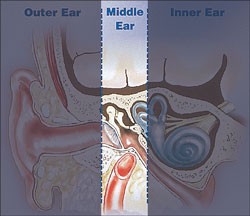
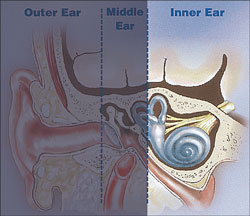
Inner Ear
Sound waves passing through the oval window initiate a wave-like movement of fluid within the cochlea. As a result, thousands of sensory hair cells are activated and, in turn, electric signals are generated. Via the acoustic nerve, the signals travel to the brain, where they are recognized as sounds.
Auditory Transduction
Sound vibrations from an object cause vibrations in air molecules, which in turn, vibrate your ear drum. The movement of the eardrum causes the bones of your middle ear (the ossicles) to vibrate. These vibrations then pass in to the cochlea, within the cochlea, the hair cells on the organ of Corti bend and cause movement of the basilar membrane. The membrane undulates in different sized waves according to the frequency of the sound. Hair cells are then able to convert this movement into electrical signals which travel along auditory nerves to hearing centres in the brain.
Hearing Loss
The ability to hear well is an important aspect of life – one which we absolutely must preserve. Today’s technology makes this easier to achieve than ever before. Those who recognize this in time and act accordingly have the best chance of counteracting this process and being able to continue hearing. Permanent hearing loss occurs when inner ear nerves become damaged and do not properly transmit their signals to the brain. Those who suffer from this condition may complain that people seem to mumble or that they hear, but do not understand, what is being said.
Hearing Loss
Predominantly, hearing loss is a natural part of growing old; just as most elderly people require reading glasses. In 9 out of 10 cases, hearing loss is age-related. Apart from this, constant exposure to loud noise, head trauma, or genetics – to name only a few – could also cause hearing loss.
A hearing loss develops gradually, almost imperceptibly. Unlike other sensory impairments – e.g. degenerated sight – a reduced sense of hearing is not perceived instantaneously; it may go unnoticed for many years.
People are creatures of habit. We can quickly adapt to reductions in our hearing capacity. We barely notice how we keep having to ask people to repeat things, how we increase the volume on the television set, or how we are no longer able to filter out the voice of the person we are talking to when there are many other conversations going on around us. This is because the deterioration of our hearing is a subtle process.
Soft whispering, the laughter of happy children, thunderous applause … the most emotional moments in our lives are ones we hear for many years to come. Sound and feeling are inseparably linked. Music can make you feel melancholy, lift your spirit, or help you dream. The words spoken by one person to another are still the best means of achieving communication and understanding between people.
The ability to hear well is an important aspect of life – one which we absolutely must preserve. Today’s technology makes this easier to achieve than ever before. Those who recognize this in time and act accordingly have the best chance of counteracting this process and being able to continue hearing. Permanent hearing loss occurs when inner ear nerves become damaged and do not properly transmit their signals to the brain. Those who suffer from this condition may complain that people seem to mumble or that they hear, but do not understand, what is being said.
The aging process is a very common cause of sensorineural hearing loss. As we get older, the inner ear nerves and sensory cells gradually die. The condition is not often medically or surgically treatable. In most cases, the symptoms can be significantly minimized with hearing aids.
Not only are signs and symptoms of hearing loss very subtle; they are also manifold and often differ from person to person. Reasons for concern may include the following:
• Asking people to repeat themselves more often than usual
• Increasing the volume of the TV and radio regardless of loved ones’ volume preference
• Having the impression that everyone mumbles
• Having the impression that certain voices, especially those of children or women, are more difficult to understand
• Straining to follow conversations and getting tired because of the extra listening effort
• Avoiding social gatherings and losing interest in activities that were once enjoyable
Degree of Hearing Loss
We weigh our body weight in kilograms, pounds or stone; measure our height in meters, feet or inches; monitor our heart rate in beats per minute. How do we measure hearing? Our hearing organs perceive sound as pitch and loudness, respectively as frequency and intensity. Low frequency sound waves produce low pitched, bass sounds while high frequencies produce high pitched, whistle sounds. Deibels (dB) are the unit used to quantify loudness (our hearing’s perception of sound intensity). A pleasant conversation, for example, has the intensity of 60 dB, a lawn mower up to 100 dB. Our ears respond to intensities between -10 dB and 120 dB.
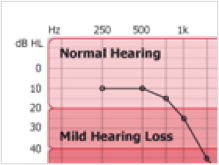
The severity of a hearing impairment depends on how loud a sound must be before an individual hears it. Degrees of hearing loss are categorized as follows:
Between “hearing well” and “hearing nothing” lies a wide range of different degrees of hearing loss. As an Audiologist, we distinguish between mild, moderate, severe and profound hearing loss. Most cases of hearing loss are categorized as mild or moderate.
The audiogram below can be described as a mild to moderate hearing loss.
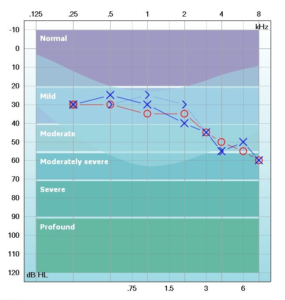
Mild hearing loss
Soft noises are not heard. Understanding speech is difficult in a loud environment.
Moderate hearing loss
Soft and moderately loud noises are not heard. Understanding speech becomes very difficult if background noise is present.
Severe hearing loss
Conversations have to be conducted loudly. Group conversations are possible only with a lot of effort.
Profound hearing loss
Some very loud noises are heard. Without a hearing aid, communication is no longer possible even with intense effort.
Types Of Hearing Loss
To someone without a hearing loss, sound is loud and clear in all areas of the speech spectrum, it would sound like this:

To someone with sensorineural or Noise Induced Hearing Loss they would hear the vowels in speech but not the consonants, so speech might sound like this:

Sensorineural hearing loss is a term used to describe a problem with the processing of sound. It is a loss of the ability to convert sound into electrical impulses that the brain can understand or a loss of the brain’s ability to transmit and process the electrical impulses.“Sensorineural” can be further divided into sensory and neural type losses. The distinction can be made with additional testing. In most cases further testing is not required.
A sensory loss is the most common type of hearing loss and is caused by the cochlea. The cochlea is filled with millions of tiny hair cells that vibrate in response to sound waves. The vibrations of the hair cells cause chemical changes which produce an electrical impulse. This is how the brain is able to interpret sound waves.
In a sensory loss the hair cells have been damaged. The more damaged hair cells there are the more severe the hearing loss. Hair cell damage can occur as a result of ageing, noise exposure or chemical damage as well as a variety of other less common causes. A neural loss is far less common than a sensory loss. It is a problem with the transmission of information through the auditory pathways of the brain.
To someone with a conductive hearing loss (CHL) the volume of speech is affected rather than the clarity, it might sound like this:

In cases of CHL the cochlea and auditory pathways of the brain function normally, but the sound arrives at a softer volume. A conductive hearing loss occurs when sound cannot travel through the outer or middle ear the normal way. Conductive hearing loss may be caused by a physical blockage in the system, such as wax build up or ear infections.
To someone with a mixed hearing loss the volume of speech is affected and the clarity, it might sound like this:

More on Hearing Loss
The ability to hear well is an important aspect of life – one which we absolutely must preserve. Today’s technology makes this easier to achieve than ever before. Those who recognize this in time and act accordingly have the best chance of counteracting this process and being able to continue hearing. Permanent hearing loss occurs when inner ear nerves become damaged and do not properly transmit their signals to the brain. Those who suffer from this condition may complain that people seem to mumble or that they hear, but do not understand, what is being said.
The term mixed hearing loss is used to describe hearing loss that has both sensorineural and conductive components. For example this may occur if someone has an underlying noise induced hearing loss and then also develops a wax blockage. Just as with a CHL the conductive component of MHL may be able to be fixed.
Hearing Protection
Extended exposure to loud and excessive noise can damage the fine hair cells in the inner ear and result in a noise-induced hearing loss.
Loud noise can be very damaging to hearing. Both the level of noise and the length of time you listen to the noise can put you at risk for noise-induced hearing loss. Noise levels are measured in decibels, or dB for short. The higher the decibel level, the louder the noise. Sounds that are louder than 85 dB can cause permanent hearing loss. The hearing system can be injured not only by a loud blast or explosion but also by prolonged exposure to high noise levels.
How can I tell if I am listening to dangerous noise levels?
• You must raise your voice to be heard.
• You can’t hear someone 1 metre away from you.
• Speech around you sounds muffled or dull after you leave the noisy area.
• You have pain or ringing in your ears (this is called “tinnitus”) after exposure to noise.
How can loud noise damage hearing?
Understanding how we hear will help you to understand how loud noise can hurt your hearing. One of the most common bad effects of loud noise on hearing is a permanent hearing loss. This happens in the following way:
• The loud sound is collected by the ear as sound waves. The sound waves travel down the ear canal toward the eardrum with enough force to disrupt the delicate hearing system. If the sound is loud enough, it can dislodge the tiny bones of the middle ear.
• The loud sound passes through the middle ear and travels to the inner ear, also known as the cochlea. The tiny hair cells lining this fluid-filled chamber can be damaged as the loud sound reaches the inner ear.
• Only healthy hair cells can send electrical impulses to the brain. It is in the brain that the sound is understood and interpreted. Hair cells damaged by loud sound cannot send the impulse to the brain for interpretation.
• Intense brief noises, like a firecracker or an explosion, can damage hair cells, as can continuous and/or repeated exposure to high levels of noise.
• Once the hair cells are damaged, there is no current treatment to repair them.
How loud is too loud?
The noise chart below lists average decibel levels for everyday sounds around you.
Painful
150 dB = fireworks at 1 metre
140 dB = firearms, jet engine
130 dB = jackhammer
120 dB = jet plane takeoff, siren
Extremely Loud
110 dB = maximum output of some MP3 players, model airplane, chain saw
106 dB = lawn mower
100 dB = hand drill, pneumatic drill
90 dB = subway, passing motorcycle
Very Loud
80–90 dB = blow-dryer, kitchen blender, food processor
70 dB = busy traffic, vacuum cleaner, alarm clock
Moderate
60 dB = typical conversation, dishwasher, clothes dryer
50 dB = moderate rainfall
40 dB = quiet room
Faint
30 dB = whisper, quiet library
More information on this topic can be found at ASHA – Audiology Information Series [PDF].
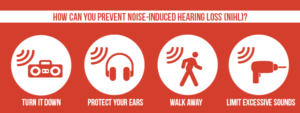
ACTIV-EARS Audiology is accredited to provide free hearing evaluation services to pensioners and war veterans (DVA cardholders) under the Australian Government Hearing Services Program. ACTIV-EARS Audiology provides hearing aids and assistive technologies for pensioners and war veterans.
How to apply for this program:
We will add you to the Hearing Services Program and print your voucher, so you can attain FREE services.
Eligibility criteria for hearing services from the federal government can be found on the Hearing Services Program website.The website is http://www.hearingservices.gov.au/wps/portal/hso/site/eligibility/programhelp/eligibility/